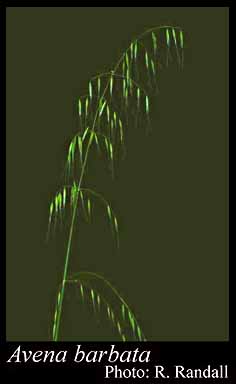- Reference
- Schrad., J.Bot.(Schrader) 1799,2:314-315 (1800)
- Conservation Code
- Not threatened
- Naturalised Status
- Alien to Western Australia
- Name Status
- Current
Erect annual, grass-like or herb, 0.3-1 m high. Fl. green, Aug to Oct. Grey-white sand, red, brown, gravelly loam, clay.







Distribution
- IBRA Regions
- Avon Wheatbelt, Carnarvon, Esperance Plains, Geraldton Sandplains, Hampton, Jarrah Forest, Mallee, Nullarbor, Swan Coastal Plain, Warren, Yalgoo.
- IBRA Subregions
- Cape Range, Dandaragan Plateau, Eastern Mallee, Edel, Fitzgerald, Geraldton Hills, Hampton, Katanning, Lesueur Sandplain, Merredin, Northern Jarrah Forest, Nullarbor Plain, Perth, Recherche, Southern Jarrah Forest, Warren, Western Mallee, Wooramel.
- IMCRA Regions
- Abrolhos Islands, Central West Coast, Leeuwin-Naturaliste, Shark Bay, WA South Coast.
- Local Government Areas (LGAs)
- Armadale, Ashburton, Bassendean, Beverley, Boddington, Boyup Brook, Bridgetown-Greenbushes, Broomehill-Tambellup, Bruce Rock, Bunbury, Busselton, Cambridge, Canning, Capel, Carnamah, Chapman Valley, Chittering, Cockburn, Coorow, Corrigin, Cranbrook, Cuballing, Cunderdin, Dalwallinu, Dandaragan, Dardanup, Denmark, Dundas, Esperance, Gnowangerup, Goomalling, Gosnells, Greater Geraldton, Harvey, Jerramungup, Kalamunda, Kalgoorlie-Boulder, Kellerberrin, Kojonup, Kondinin, Koorda, Kulin, Lake Grace, Mandurah, Manjimup, Melville, Merredin, Mingenew, Moora, Morawa, Mount Marshall, Mundaring, Murray, Narembeen, Narrogin, Nedlands, Northam, Northampton, Perth, Pingelly, Plantagenet, Quairading, Ravensthorpe, Rockingham, Serpentine-Jarrahdale, Shark Bay, South Perth, Stirling, Swan, Three Springs, Toodyay, Victoria Plains, Wagin, Wanneroo, Waroona, Wickepin, Wongan-Ballidu, Wyalkatchem, York.
Management Notes (for the Swan NRM Region)
General Biology. Growth form. Grass. Life form. Annual, caespitose. Reproduction. Seed. Dispersal. Possibly wind, agricultural machinery, livestock and mammals (on fur). Photosynthetic Pathway. C3. Seedbank persistence. 6 months to 3 years (shorter if not buried).
Notes. Able to outcompete native grasses. Is allelopathic and forms extensive, fibrous root system. Can increase fire frequencies. Reportedly needs disturbance to establish. Capable of adapting morpho-physiological traits to environmental conditions, such as different water and light availability, higher mean temperatures and altitude. Self-pollinated. Produces prolific seed. Buried seed often remains dormant until exposed by cultivation or other disturbance. Predominantly germinates after onset of autumn rains, compared with Avena fatua which germinates from autumn to spring. Has no adaptions for long distance dispersal. Herbicide resistance has been recorded.
Additional information. Origin. Mediterranean/Asia. History of use/introduction. Contaminant of grain. Similar exotic species. Avena fatua.
Suggested method of management and control. Spray at 3-5 leaf stage with Fusilade® Forte at 16 ml/10 L + wetting agent or for generic fluazifop-p (212g/L active ingredient) 10mL/10L or 0.5L/ha + wetting agent. Repeat over the following 2 years. Aim to prevent seed production. Read the manufacturers' labels and material safety data sheets before using herbicides. For further information consult the Australian Pesticides and Veterinary Medicines Authority to determine the status of permits for your situation or state.
Management Calendar
| Calendar Type | Jan | Feb | Mar | Apr | May | Jun | Jul | Aug | Sep | Oct | Nov | Dec | Comments |
|---|---|---|---|---|---|---|---|---|---|---|---|---|---|
| Active Growth | Y | Y | Y | Y | Y | Y | |||||||
| Germination | Y | Y | O | O | Seed germinates after rains | ||||||||
| Flowering | Y | Y | Y | ||||||||||
| Fruiting | Y | ||||||||||||
| Optimum Treatment | Y | Y | Y | Y |
Legend: Y = Yes, regularly, O = Occasionally, U = Uncertain, referred by others but not confirmed.
References
- Baskin, C.C. & Baskin, J.M. (1998) Ecology of seed dormancy and germination in grasses. In Population biology of grasses (ed. G.P. Cheplick) . Cambridge University Press, Cambridge, UK.
- Brown, K. & Brooks, K. (2002) Bushland Weeds: A Practical Guide to their Management. Environmental Weeds Action Network, Greenwood.
- California Exotic Pest Plant Council & the Southwest Vegetation Management Association (2003) Criteria for categorizing invasive non-native plants that threaten wildlands, Part IV, plant assessment form -Avena barbata L..
- Carr, G.W., Yugovic, J.V. & Robinson, K.E. (1992) Environmental weed invasions in Victoria. Department of Conservation and Environment, Melbourne.
- HEAR.org (2009) Avena barbata (Poaceae). Global Compendium of Weeds. URL: http://www.hear.org/gcw/species/avena_barbata/ - Accessed August 2009.
- Hussey, B.M.J., Keighery, G.J., Dodd, J., Lloyd, S.G. & Cousens, R.D. (2007) Western Weeds. A guide to the weeds of Western Australia. 2nd Edition. The Plant Protection Society of Western Australia, Victoria Park.
- Medd, R.W. (1996) Wild oats - what is the problem. Plant Protection Quarterly, 11 (SUPPL. 1): 183-184.
- Moore, C.B. & Moore, J.H. (2002) Herbiguide, the pesticide expert on a disk. Herbiguide, PO Box 44 Albany, Western Australia, 6330.
- Moore, J.H. & Wheeler, J. (2008) Southern weeds and their control. DAFWA Bulletin 4744.
- Nugent, T., Storrie, A. & Medd, R. (1999) Managing Wild Oat (Avena spp). Grains Research and Development Corporation and CRC for Weed Management Systems.
- Sharma, M.P. & Vanden Born, W.H. (1978) The Biology of Canadian weeds, Part 27 Avena-Fatua. Canadian Jounal of Plant Science, 58 (1): 141-158.
- Somersalo, S., Makela, P., Rajala, A., Nevo, E. & Peltonen-Sainio, P. (1998) Morpho-physiological traits characterizing environmental adaptation of Avena barbata. Euphytica, 99 (3): 213-220.
- Standish, R.J., Cramer, V.A. & Hobbs, R.J. (2008) Land-use legacy and the persistence of invasive Avena barbata on abandoned farmland. Jounal of Applied Ecology, 45 (6): 1576-1583.
- United States Department of Agriculture (2001) The Plants Database, Version 3.1. URL: http://plants.usda.gov - Accessed December 2007. National Plant Data Center, Baton Rouge, LA 70874-4490 USA.